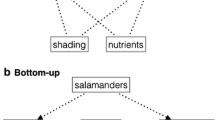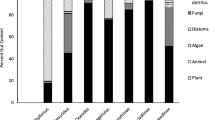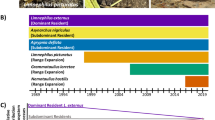Abstract
Determining the effects of species loss on ecosystems has received considerable attention given the current threats many ecosystems are facing. A significant body of research has yielded many insights to this question, but this work has been limited by a focus on ecosystems where primary production plays a significant role in energy transfer. As many ecosystems rely on energy sources that are not derived from in situ production, there is a need to better understand how species loss will affect ecosystems of varying trophic states. To examine the effects of species loss on an ecosystem that is not reliant on in situ primary production, we manipulated the larval amphibian community of temporary forest ponds. These ponds are heterotrophic systems that rely on allochthonous inputs of detritus as a basal energy source. The larvae of two amphibian species that are prone to local extinction, wood frogs (Lithobates sylvatica) and spotted salamanders (Ambystoma maculatum), were removed from ponds and net ecosystem production was monitored. We found no effects of the removal of these top consumers on ecosystem functioning or on lower trophic groups (i.e., zooplankton, algae, bacteria). While amphibians can influence food web dynamics in other systems, their influence on system processes in temporary forest ponds appears to be limited. We hypothesize that the lack of any effects is due to the microbial degradation of detritus “swamping” the system, providing more than enough energy to maintain the food web, and/or due to omnivory dampening species interactions. These data indicate that the functioning of heterotrophic systems may be inherently stable due to internal dynamics that minimize interaction strengths among trophic groups.

Similar content being viewed by others
References
Balvanera P, Pfisterer AB, Buchmann N, He JS, Nakashizuka T, Raffaelli D, Schmid B (2006) Quantifying the evidence for biodiversity effects on ecosystem functioning and services. Ecol Lett 9:1146–1156
Batzer DP, Palik BJ, Buech R (2004) Relationships between environmental characteristics and macroinvertebrate communities in seasonal woodland ponds in Minnesota. J North Am Benthol Soc 23:50–68
Bonner LA, Diehl WJ, Altig R (1997) Physical, chemical, and biological dynamics of five temporary dystrophic forest pools in central Mississippi. Hydrobiologia 353:77–89
Cardinale BJ, Srivastava DS, Duffy JE, Wright JP, Downing AL, Sankaran M, Jouseau C (2006) Effects of biodiversity on the functioning of trophic groups and ecosystems. Nature 443:989–992
Chase JM (2003) Strong and weak trophic cascades along a productivity gradient. Oikos 101:187–195
Cole JJ, Pace ML, Carpenter SR, Kitchell JF (2000) Persistence of net heterotrophy in lakes during nutrient addition and food web manipulation. Limnol Oceanogr 45:1718–1730
Colon-Gaud C, Whiles MR, Kilham SS, Lips KR, Pringle CM, Connelly S, Peterson SD (2009) Assessing ecological responses to catastrophic amphibian declines: patterns of macroinvertebrate production and food web structure in Panamanian streams. Limnol Oceanogr 54:331–343
de Ruiter PC, Neutel AM, Moore JC (1995) Energetics, patterns of interaction strengths, and stability in real ecosystems. Science 269:1257–1260
Dodds WK, Cole JJ (2007) Expanding the concept of trophic state in aquatic ecosystems: it’s not just the autotrophs. Aquat Sci 69:427–439
Downing AL (2005) Relative effects of species composition and richness on pond ecosystem properties in ponds. Ecology 86:701–715
Duarte CM, Prairie YT (2005) Prevalence of heterotrophy and atmospheric CO2 emissions from aquatic ecosystems. Ecosystems 8:862–870
Dudgeon D (2010) Prospects for sustaining freshwater biodiversity in the 21st century: linking ecosystem structure and function. Curr Opin Environ Sustain 2:422–430
Duffy JE (2003) Biodiversity loss, trophic skew and ecosystem functioning. Ecol Lett 6:680–687
Gessner MO, Swan CM, Dang CK, McKie BG, Bardgett RD, Wall DH, Hattenschwiler S (2010) Diversity meets decomposition. Trends Ecol Evol 25:372–380
Hairston NG Jr, Hairston NG Sr (1993) Cause-effect relationships in energy flow, trophic structure, and interspecific interactions. Am Nat 142:379–411
Hairston NG Sr, Smith FE, Slobodkin LB (1960) Community structure, population control, and competition. Am Nat 94:421–425
Hall RO Jr, Meyer JL (1998) The trophic significance of bacteria in a detritus-based stream food web. Ecology 79:1995–2012
Harper EB, Rittenhouse TA, Semlitsch RD (2008) Demographic consequences of terrestrial habitat loss for pool-breeding amphibians: predicting extinction risks associated with inadequate size of buffer zones. Conserv Biol 22:1205–1215
Harris PM (1995) Are autecologically similar species also functionally similar? A test in pond communities. Ecology 76:544–552
Holomuzki JR, Collins JP, Brunkow PE (1994) Trophic control of fishless ponds by tiger salamander larvae. Oikos 71:55–64
Jansson M, Persson L, De Roos AM, Jones RI, Tranvik. LJ (2007) Terrestrial carbon and intraspecific size-variation shape lake ecosystems. Trends Ecol Evol 22:316–322
Kupferberg S (1997) Facilitation of periphyton production by tadpole grazing: functional differences between species. Freshw Biol 37:427–439
Lecerf A, Richardson JS (2009) Biodiveristy–ecosystem function research: insight gained from streams. River Res Appl 26:45–54
Leeper DA, Taylor BE (1998) Abundance, biomass and production of aquatic invertebrates in Rainbow Bay, a temporary wetland in South Carolina USA. Arch Hydrobiol 143:335–362
Lindeman RL (1942) The trophic-dynamic aspect of ecology. Ecology 23:399–418
Mikola J, Setala H (1998) No evidence of trophic cascades in an experimental microbial-based food web. Ecology 79:153–164
Moore JC, Berlow EL, Coleman DC, deRuiter PC, Dong Q, Hastings A, Collins Johnson N, McCann KS, Melville K, Morin PJ, Nadelhoffer K, Rosemond AD, Post DM, Sabo JL, Scow KM, Vanni MJ, Wall DH et al (2004) Detritus, trophic dynamics and biodiversity. Ecol Lett 7:584–600
Pace ML, Cole JJ (1994) Comparative and experimental approaches to top-down and bottom-up regulation of bacteria. Microb Ecol 28:181–193
Pace ML, Cole JJ, Carpenter SR, Kitchell JF (1999) Trophic cascades revealed in diverse ecosystems. Trends Ecol Evol 14:483–488
Pace ML, Cole JJ, Carpenter SR, Kitchell JF, Hodgson JR, Van de Bogert MC, Bade DL, Kritzberg ES, Bastviken D (2004) Whole-lake carbon-13 additions reveal terrestrial support of aquatic food webs. Nature 427:240–243
Petchey OL, Downing AL, Mittlebach GG, Persson L, Steiner CF, Warren PH, Woodward G (2004) Species loss and the structure and functioning of multitrophic aquatic systems. Oikos 104:467–478
Petranka JW (1998) Salamanders of the United States and Canada. Smithsonian Institution Press, Washington, D.C.
Polis GA, Strong DR (1996) Food web complexity and community dynamics. Am Nat 147:813–846
Polis GA, Anderson WB, Holt RD (1997) Toward an integration of landscape and food web ecology: the dynamics of spatially subsidized food webs. Annu Rev Ecol Syst 28:289–316
Regester KJ, Lips KR, Whiles MR (2006) Energy flow and subsidies associated with the complex life cycle of ambystomatid salamanders in ponds and adjacent forest in southern Illinois. Oecologia 147:303–314
Reiss J, Bridle JR, Montoya JM, Woodward G (2009) Emerging horizons in biodiversity and ecosystem functioning research. Trends Ecol Evol 24:505–514
Romanuk TN, Vogt RJ, Kolasa J (2009) Ecological realism and mechanisms by which diversity begets stability. Oikos 118:819–828
Rubbo MJ, Kiesecker JM (2004) Leaf litter composition and community structure: translating regional species changes into local dynamics. Ecology 85:2519–2525
Rubbo MJ, Kiesecker JM (2005) Amphibian breeding distribution in an urbanized landscape. Conserv Biol 19:504–511
Rubbo MJ, Cole JJ, Kiesecker JM (2006a) Terrestrial subsidies of organic carbon support net ecosystem production in temporary forest ponds: evidence from an ecosystem experiment. Ecosystems 9:1170–1176
Rubbo MJ, Shea K, Kiesecker JM (2006b) The influence of multi-stage predation on population growth and the distribution of the pond-breeding salamander (Ambystoma jeffersonianum). Can J Zool 84:449–458
Seale DB (1980) Influence of amphibian larvae on primary production, nutrient flux, and competition in a pond ecosystem. Ecology 61:1531–1550
Shurin JB, Gruner DS, Hillebrand H (2006) All wet or dried up? Real differences between aquatic and terrestrial food webs. Proc R Soc B 273:1–9
Skelly DK (2002) Experimental venue and estimation of interaction strength. Ecology 83:2097–2101
Skelly DK, Golon J (2003) Assimilation of natural benthic substrates by two species of tadpoles. Herpetolgica 59:37–42
Smith DC, Azam F (1992) A simple, economical method for measuring bacterial protein synthesis rates in sea water using 3H-leucine. Mar Microb Food Webs 6:107–114
Thebault E, Loreau M (2003) Food-web constraints on biodiversity–ecosystem functioning relationships. Proc Nat Acad Sci 100:14949–14954
Tranvik K (1992) Allochthonous dissolved organic matter as an energy source for pelagic bacteria and the concept of the microbial loop. Hydrobiologia 229:107–114
Wallace JB, Eggert SL, Meyer JL, Webster JR (1997) Multiple trophic levels of a forest stream linked to terrestrial leaf litter inputs. Science 277:102–104
Wetzel RG (1995) Death, detritus, and energy flow in aquatic ecosystems. Freshw Biol 33:83–89
Whiles MR, Lips KR, Pringle CM, Kilham SS, Brenes R, Connelly S, Colon Gaud JC, Hunte-Brown M, Huryn AD, Montgomery C, Peterson S (2006) The consequences of amphibian population declines to the structure and function of neotropical stream ecosystems. Front Ecol Environ 4:27–34
Whiles MR, Gladyshev MI, Sushchik NN, Makhutova ON, Kalachova GS, Peterson SD, Regester KJ (2010) Fatty acid analyses reveal high degrees of omnivory and dietary plasticity in pond-dwelling tadpoles. Freshw Biol 55:1533–1547
Wilbur HM (1997) Experimental ecology of food webs: complex systems in temporary ponds. Ecology 78:2279–2302
Acknowledgments
We thank J. Chase for reviewing an earlier draft of this manuscript and J. Falkenbach and L. Grove for assistance with field work. Financial support was provided by the NIH/NSF Ecology of Infectious Disease Program (1R01ES11067-01 to JMK) and NSF (IBN) Grant #0131229 to JMK, and the Department of Biology, Pennsylvania State University.
Author information
Authors and Affiliations
Corresponding author
Rights and permissions
About this article
Cite this article
Rubbo, M.J., Belden, L.K., Storrs-Mendez, S.I. et al. Species loss in the brown world: are heterotrophic systems inherently stable?. Aquat Sci 74, 397–404 (2012). https://doi.org/10.1007/s00027-011-0234-3
Received:
Accepted:
Published:
Issue Date:
DOI: https://doi.org/10.1007/s00027-011-0234-3




